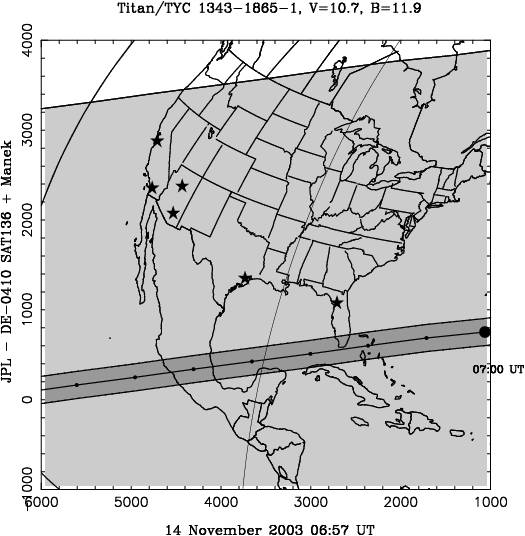

About six hours after the TYC 1343-1615-1 even, the star TYC 1343-1865-1 (B=11.9, V=10.7) will be occulted by Titan as seen from South Western Europe, North and Central Americas.
Astrometry |
Note: the diagrams below are provided in chronological order, so the latest (and supposedly better) diagrams are at the end. Also, the radius of Titan's atmosphere is taken equal to 3100 km. Inside that radius, an observer should see a drop of stellar signal larger than a few percents. The "half-light radius" (the radius of the shadow where the stellar flux has been divided by two) is a little smaller, of the order of 3000 km.
The Vizier site provides the
following position for 14 November 2003 (proper motion taken into
account, no annual parallax considered):
alpha= 06:55:17.7733
delta=+22:06:01.168
with typical errors of 50 mas.
The shadow of Titan's atmosphere (light grey area) and the central flash region (dark grey area) are shown in the figures below, with the center of the shadow plotted every minute.
The shadow moves from the right to the left.
Left panel: according to the IMCCE online ephemeris (DE-0406LE-0406)
Right panel: according to the JPL Horizon online ephemeris (DE-0406LE-0406 + SAT136)
Again, little difference is visible.



We can apply again the offset derived by R.C Stone quoted above to
correct for O-C in the saturnian system (21 mas in alpha, -18 mas in
delta for Titan). Furthermore, the position of TYC
1343-1865-1 is now available in the UCAC2-beta catalog. According to
Jan Manek, the position corrected for proper motion on 14 November
2003 (no annual parallax applied) is:
alpha= 06:55:17.7690
delta=+22:06:01.226
with typical errors of 20 mas. This changes the position of the star
by -60 mas in alpha and +58 mas in delta, wrt the Vizier position,
resulting in the following prediction:
 |
 |
 |
If one uses JPL ephemeris DE410 for Saturn (Myles Standish) and the SAT136 ephemeris for Titan (Bob Jacobson), then one gets the following predictions:
 |
 |
The two predictions above differ by about one minute in time, and by about 150 km (0.025 arcsec) perpendicular to the shadow track, i.e. half of the full width of the central flash. This should be considered as the typical error made so far in the predictions.
The only way to improve the astrometry further is to observed the Saturnian system as it will come close (1 arcmin or so) to TYC 1343-1865-1 on October 4, 2003. Differential astrometry could then improve the accuracy of the predictions. Such observations are most welcome!
The illumination of the Earth will be as follows:

Photometry |
Below is a table of measurements made by Jean Lecacheux with the 1-m telescope at Pic du Midi. The fluxes are in arbitrary units, the depth is = star/(star + Titan) and the S/N is defined as = star/2*sqrt(star+Titan). The S/N is thus a measure of how significant the drop of stellar signal is wrt the photon noise. The values of S/N in the last column are rather arbitrary, but their comparison may be useful when choosing a filter.
One can see that the CH4 filter, although is gives a much better contrast, yields the poorest S/N due to the lack of photons in that filter.
The wide 530-900 nm filter seems to be the best compromise. This depends, however, on the detector and should be modulated according to the spectral response of each detector. Tests are advised!
Filter |
Flux Titan |
Flux star |
Depth |
S/N |
R |
11330 |
1535 |
0.12 |
6.7 |
530-900 nm |
23393 |
3251 |
0.12 |
10.0 |
V |
4723 |
644 |
0.12 |
4.4 |
> 700 nm |
9794 |
1734 |
0.15 |
8.1 |
I |
4048 |
805 |
0.17 |
5.8 |
893/5 (CH4) |
27.9 |
14.7 |
0.35 |
1.1 |